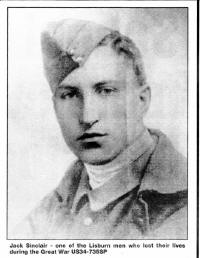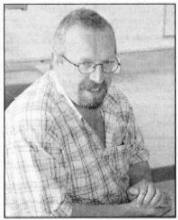
TALES OF THE GREAT WAR THAT LED TO
AN EPIC WORK OF COMMEMORATION
|
TEACHER PAT GEARY TELLS ALISTAIR BUSHE ABOUT HIS DATABASE ON LISBURN'S CONNECTIONS TO CONFLICT |
 |
 |
| Pat Geary. US24-806SP |
TALES he heard from his grandmother about the Great War have led to a local man producing what is set to become the definitive database about Lisburn people and the their role in the 20th century's bloodiest conflict.
Pat Geary used to listen intently as his grandmother Mary Best, who served in the Imperial Military Nursing Auxiliary during the Great War, spoke of those times.
Mary served in Prance and on hospital ships in the Mediterranean Ocean.
"That was the making of her life, it would not be an exaggeration to say that it changed her life," said Pat, a teacher at Friends School. "When I was very young she came and lived with us and she used to tell many stories about the war."
That has led Pat to create the website which contains just about every detail you could find about Lisburn's connection with the Great War of 1914 to 1918.
The database and casualty list contains details of over 900 men and women with a Lisburn connection who died during the conflict.
Pat has spent the best part of two decades researching it. It includes individuals in the Lisburn City Council area, stretching from Dunmurry in the east to Moira in the west, and from Glenavy in the north to Dromara in the south.
The database, which can be accessed through the Friends' School website, contains information and biographical details about people who were born or lived in the Lisburn area or whose next of kin lived there.
Also included are those who are buried in the Lisburn borough or who are commemorated on one or more of its memorials.
It's the culmination of nearly two decades of work undertaken by Pat, who even as a student in Coleraine was always interested by history.
"I've been doing this for the guts of 17 or 18 years now. The war has always fascinated me," he continued. "I went to school in Coleraine and I always went to a remembrance service every year. I remember standing at the service one day and it suddenly occurred to me that some people there didn't know the reality. I was 14 or 15 at the time and I said to myself that some day I was going to find out."
Of course to compile a database containing such a wealth of information involves research, and considerable amounts of it.
One day Pat started his search by going to the Lisburn War Memorial in Castle Street and writing down all the names of those listed.
He did likewise at the other memorials at the junction of Mill Street and Grand Street at Hilden and at Main Street in Hillsborough.
These provided the starting point. Before long more information was added from church memorials, including the one at Friends', the Orange Hall in Glenavy, and from the headstones across Lisburn.
"Almost invariably you found one, two or three headstones of people who were killed in the First World War," recalled Pat.
He also used the War Office casualty lists, published in 1921 under the title, 'Soldiers Who Died in the Great War', Ireland's Memorial Record Published by the Irish National War Memorial Trust in 1923 and the records of the Commonwealth War Graves Commission, to provide the basic details about what units men served in, the date of their death and their place of burial or commemoration.
More personal details were found in attestation papers and other records stored in the Canadian National Archive and the Australian War Memorial. These are accessible on the internet.
Information about what background people came from and what happened to them was researched in the local newspapers of the day, the 'Standard' and the 'Herald'.
"It is access to these sources that has been instrumental in creating a database of the Great War and more than 900 casualties from the local area," said Pat.
The information on the Friends' website is in two similar formats. The casualty list gives short biographies while the database records the basic details under a series of headings ranging from surname, place of birth and address to place and date of death, age, and place of burial or commemoration. To access the database and casualty list go to https://www.friendsschoollisburn.org.uk and select 'Academic'. Then scroll down to 'Departments' and select 'History and Politics'. There you will find a link to the Great War Archive.
Pat looks back on his work with some satisfaction but he never forgets the inspiration behind his work. "It all goes back to my grandmother," he added.
Lisburn men who fought together and died together
PAT Geary's Great War database reveals many fascinating and poignant pieces of information about the role and fate of Lisburn servicemen.
Just like in the rest of the United Kingdom, Lisburn men joined up with their friends in local battalions, particularly the 11th and 13th battalions of the Royal Irish Rifles. As the war unfolded they died together.
There were more than 130 local deaths on July 1, 1916 alone, the opening day of the Battle of the Somme. Before that month was out, the total rose to nearly 170. In total, over one quarter of all the casualties on the list occurred around that area.
Besides the Somme, other battles were particularly significant and harrowing for local families too. These included Festubert, Neuve Chapelle and Loos in 1915, and Gallipoli in the same year. Many also died at Langemarek and Cambrai in 1917, the great offensives of 1918, and Ypres Salient just about any time from November 1914 on.
Of course the Great War did not just involve great battles, it was often a more muted affair.
On June 28, 1916 seven men in 13 RIR, most from Hillsborough and Culcavey, were killed in Martinsart near Thiepval when a German shell landed in their midst.
Just over three months later 12 then, mainly from Lisburn, were killed in what was probably a gas attack launched close to the southern end of the Messiness Ridge in Belgium.
The casualty list that appeared in the Lisburn Standard shortly after contained 70 local names and is one of the longest pub-lished at any time during the war.
Many of those who died came from ordinary backgrounds. William Gribben was a hairdresser and Samuel Haire a civil service clerk for instance.
Six were policemen and many more were employed at Barbours, the Island Spinning Company and other linen businesses, often living in terraced houses nearby.
These were men with little or no military experience. Some had served in the Boer War but for many training with the South Antrim Volunteers, the local battalion of the UVF was the closest they bad come to experiencing modern warfare.
'These were men who marched into the town early in September 1914 and enlisted in the Assembly Rooms and joined up in the II Battalion Royal Irish Rifles which was to become part of the Ulster Division. Eager to show their patriotism, they were also following the example of their commanding officer Major Adam Jenkins.
It was reported in the Lisburn Standard that a 'splendid percentage' of members of the Lisburn UVF joined the army at the outbreak of war - many like Jenkins were to be casualties.
Others came from the opposite side of the political fence. On May 28, 1915 the Standard reported that during the week 'a goodly number' of nationalists had enlisted and that the local company of the National Volunteers, numbering 120 strong, had held a farewell route march in the town.
At the end of the year the paper published a 'Lisburn Churches Roll of Honour', listing the names of men from the town who were serving. Some 212, nearly one quarter of the total, were parishioners from Lisburn Roman Catholic Church.
12/09/2003
